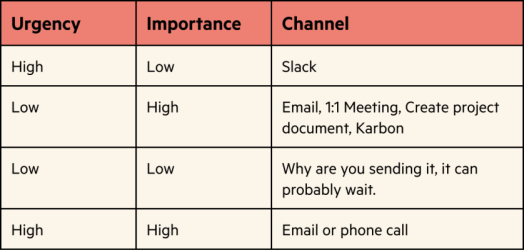How Karbon uses Slack: 10 tips for reclaiming sanity and productivity

Stuart McLeod
Co-Founder, Karbon
There is an underlying assumption about today’s software and technology that openness and transparency is a good thing. And that’s actually true. We encourage transparency at Karbon and wouldn’t have it any other way. However...

Tools like Slack assume that everyone’s opinion is wanted, warranted, valid and welcome. Where honestly, at times, it’s not. By its very nature, transparency and openness allow transparent and open opinions. But if I was to weigh in on every little operational detail at Karbon, I’d frustrate others, slow down decision-making and contribute to chaos.
So, perhaps keep this in mind: it’s great to be open and participatory in conversations, but that doesn’t mean you need to weigh in everywhere. Or in the words of the great Richie Benaud:
“Put your brain into gear and if you can add to what's on the screen then do it, otherwise shut up.”
To encourage more productive collaboration between teams, I’ve outlined 10 Slack etiquette tips for all Karbon employees to consider. I thought I’d share it with you too.
#1 Turn off the distracting ‘pinging’ noise
That ch-ch-ch sound we’ve come so used to hearing often disrupts focus and can get in the way of deep focus work. At Karbon, we highly recommend turning it off. Slack was built by gamers. They know the noises and the red dot cause a psychosomatic response and will bring you back into the app at any given opportunity. Muting the notification sounds will greatly increase your chance of staying more focused and completing tasks.
#2 Is Slack the right place for this?
Before writing in Slack, ask yourself: Can it wait? Does your recipient need to be distracted right here, right now with your musings? Consider any of these alternatives:
Mark the topic for your 1:1 meeting with the recipient
Write it in an email and schedule send (or schedule send directly in Slack)
Create a Karbon work item
Call the recipient
Go and see them if they’re near you
If you have to use Slack, then consider the following:
Don’t write a wall of text
If your message is more than 3 sentences, then stop. If you’re going to the effort of actually writing something that might need a table of contents to keep it organized, then Slack is not the place for what you’re about to write.
Are you writing about a decision that needs to be made amongst a group of people? It would be best to write a document that allows the group to consider the policy or procedure and then share a link via Slack.
Are you talking about something that happens every month, quarter, 6 months or year? If so, then Slack is not the place for it. You’re never going to find it again and you may need to re-write it down the road.
If you still feel the need to write a wall of text, then you must have a link to further information. It’s safe to assume only a small percentage of people at your firm read any given Slack message. Once it moves beyond the next post, it’s gone. Consider doing your colleagues a service by documenting long-term information in a lasting format.
Use emojis and bullets
This will help people better navigate and consume your message. Don’t go overboard though. This is work, not Sunday brunch. Below is an example of what I mean by a good balance of emojis and text. Each week, our Content Marketing Manager, Jess Marcello, provides an update on what has been published to Karbon Magazine, and this is how she does it:

#3 Watch your tone
Slack is notorious for losing tone and making an innocent remark sound derogatory or flippant.
Remember, we often multitask while writing things in Slack. And being distracted can lead you to conveying a tone that you didn’t actually mean to, which results in unnecessary increased anxiety amongst your colleagues.
Voice and video messages are an ideal way to preserve the human voice’s warmth and context. Communicating this way eliminates ambiguity; if you get a written message from a colleague, it might not be clear if it’s sincere or sarcastic, but with voice, tone is immediately perceivable.
#4 Create a channel for each project and develop channel naming conventions
It’s common practice to have team-specific channels. And while they do serve a purpose, you still need a project-specific channel to handle the intricacies of separate initiatives in a forum with context.
Let’s walk through an example to see how project-specific channels help:
There was a client portal migration project that happened a little over 8 months ago. Let’s say you want to collect some information on it. The project was mainly being discussed in the #tech channel. Seems pretty straightforward, right? But as you open and navigate the timeline to 8 months ago, you realize that there were 25+ other software discussions in there.
It took you a while (if ever) to find what you were really looking for.
That, right there, is why you need project-specific channels.
Naming conventions are also key to keeping Slack manageable. Nothing drives people mad like dozens of randomly named channels for the same project. The team at Why Blu showcased how Slack channels are set up for their accounting firm to keep communication organized. Take a look below:

#5 Slack is multi-purpose
It’s okay to have off-topic channels and discussions relating to all kinds of things. If you want to plan a baby shower, post pics of cats, write stories, play games or tell jokes, that’s fine—in fact, at Karbon, it’s encouraged. Just remember rule #4 and keep it contained to a channel so those who are not interested in Game of Thrones don’t have to hear and/or read about it.
#6 Slack is timely, but not that timely
One of the benefits and curses of Slack is its natural capacity to be asynchronous. Multiple conversations can happen at once and people can duck in and out of conversations when they feel like or when they are required. But it is never okay to dismiss someone’s lack of input because you’ve created a deadline that is merely of your own making.
If there are deadlines for work or input required, then you should be planning ahead. And most likely, you should be using a different mechanism for requesting feedback.
It’s important to set expectations accordingly. Here is a guide for quick decision-making that we use at Karbon:

#7 After work hours etiquette
With the exception of being available during emergencies, don’t make it a habit.
If you are an employee:
Turn off notifications after work hours
Use Slack only on your work devices
If you are a manager, leader, or CEO:
Avoid writing to your team after working hours (if it can be helped due to time zone differences)
Don’t assume your employees will be available outside of their working hours if it isn’t an emergency
Use scheduled send. There’s no reason to bother others on their weekend or holiday unless it’s highly urgent, in which case you should use a different mechanism of communication.
#8 Set up your photo and profile
Photos should be recent, accurate and clear. Growing companies frequently have newcomers. Slack then becomes a directory of names and faces that can help everyone figure out who’s who. Not only does this make your organization run smoothly, it helps avoid the embarrassment of forgetting someone’s name because you can easily look it up.
#9 Set your status regularly
Setting a status for yourself lets your colleagues know your availability and your location. For example, if you see that someone is sick or on vacation, you know they are unavailable today. In this case, you’re better off seeking help elsewhere instead of waiting on them.
Tip 1: If you have the calendar integration synced with Slack, your status will automatically change to ‘In a meeting’ when you have an event on your calendar and you are marked as busy.

Tip 2: If you are running behind on tasks and need to focus, try the ‘Under immense pressure’ status to let folks know that now is not the best time for chit-chat.

Of course, you can also create custom statuses to better-suit your actual status.
#10 Use reactions generously
They help with acknowledging that you’ve read or understood what’s been put in front of you. The person at the other end doesn’t know if you’ve read something or understood something if you don’t acknowledge it. Respond with text carefully and considerately (see tip #3). But be generous and over the top with your emoticon reactions! They don’t create a notification, so you’re not annoying anyone either.
For example, this was the reaction to our recent website redesign. Our team are big fans of custom emojis.

Bottom line: Collaborate with mindfulness in Slack
Slack and instant messaging have greatly accelerated the speed of teamwork and collaboration. But like most technology breakthroughs, it’s a double-edged sword that needs human intervention to control its unintended consequences.
When you use Slack at work, it’s imperative to consider when, how, and why you’re choosing this channel to communicate over others. Be mindful of whether your action on Slack is contributing to the productivity of your peers, or diminishing it. When in doubt, you can always refer back to the 10 tips above as a baseline guide.
The saying from Confucius applies here:
“Don’t do unto others what you don’t want done unto you.”
